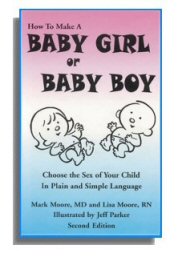|
|
| Ask Dr Moore |
|
Dr. Mark Moore, best-selling author of the gender selection book Baby Girl or Baby Boy--Choose the Sex of Your Child, answers readers' questions on pregnancy and pediatrics. ***
One of the most common complaints of new parents, a baby that does not sleep well, had become a personal issue for us with our own baby. Because my wife and I had previously been spoiled by good sleepers, this baby’s ability to stay awake surprised us, as did the strength of its cry at three in the morning. As you all know, each baby is an individual, with its own personality, time clock and disposition. During the first six weeks of an infants life, they feed frequently every 2 to 3 hours around the clock. On or about two months of age, some babies settle into a pattern of longer nighttime sleeping. Some babies can be given a nite-time bottle feeding, be placed in the crib awake and will sleep 12 hours straight until the next morning. Other infants will cry for hours until exhausted, then sleep for an hour and be awake again. There is nothing more nerve-shattering than the sound of a crying baby in a crib in the middle of the night. Well, maybe the sound of crying twins or triplets. A baby that doesn’t sleep at night means tired parents (see previous column on New Parents and Sleep Deprivation). "Putting the baby down" or "getting the baby to sleep" at bedtime for a nap is an entirely different subject than is "the baby’s having difficulty staying asleep" or "the baby has an interrupted sleep pattern". The focus of this column is the latter, that is, mid-sleep awakenings and babies having trouble staying asleep. First, a baby’s sleep problem can be a sign of a medical illness. Anything that may cause the baby pain or discomfort can affect their sleep pattern, the depth of their sleep and their irritability levels. An earache (otitis media), sore throat, a viral illness like a cough or cold, teething pain from a new tooth breaking through or a simple fever can all be sources of irritation to the baby. Upper airway congestion can make it hard for the baby to breathe, so much so, that it disturbs its sleep pattern. An observant parent will notice the infant’s behavior during the day, watch for a clue to their medical well-being, and give them the necessary medicines such as Tylenol/Acetaminophen, Motrin/ibuprofen, or Benadryl/antihistamines to treat their symptoms and improve their comfort. If a baby is otherwise healthy, but continues to awaken frequently every two hours to feed, what is the best way to get the infant to sleep longer? Where a pattern of awakening develops and you’ve made sure there is no medical cause or specific incident causing the baby to cry, it may be the infant has become "conditioned" to cry in an effort to gain attention and be fed. When you respond to an older infants middle of the night cry, and the baby immediately stops crying (even smiles sometimes), this is often a sign that the baby is well, and has become accustomed to a pattern of waking and feeding. My friend and family physician, Dr. Karl Hempel reminded us of what we already know, but had not applied. To break this habit, we must let the baby cry, for two hours if necessary, and not respond by taking the infant out of the crib. After five to seven days, the baby will unlearn the undesirable behavior. It sounds simple but the application of this knowledge and information is harder than it looks. It is natural to respond to a baby’s cries by lifting it up and comforting it. Our baby needed to sleep better and so did we. Thus began our training nights. It can almost break your heart to hear the little thing crying its eyes out. After two days, the crying episodes spaced out to four hours and by weeks end, they stopped completely. The baby still gurgles occasionally, but for the most part, we are
all sleeping longer. Again, before using this approach, see your family
doctor or pediatrician to ensure the baby’s irritability does
not have a medical basis. *** Readers may send questions to our email address. This column is for informational purposes only and is not a substitute for professional or medical advice. * * * |
This web page is best viewed in 1024 x 768 resolution.
Last updated April 2009. Over 1,194,000 page views.
This web site is maintained by Washington Publishers, Tallahassee Florida,
USA, and uses Sun Domains and Software.
To have objectionable or potentially copyrighted material evaluated for removal
on this site, click here.
Copyright © 2000 - 2009 All Rights Reserved Washington Publishers
Washington Publishers is not an affiliate of Inside
Washington Publishers.
Learn more about our current privacy
and information practices.

